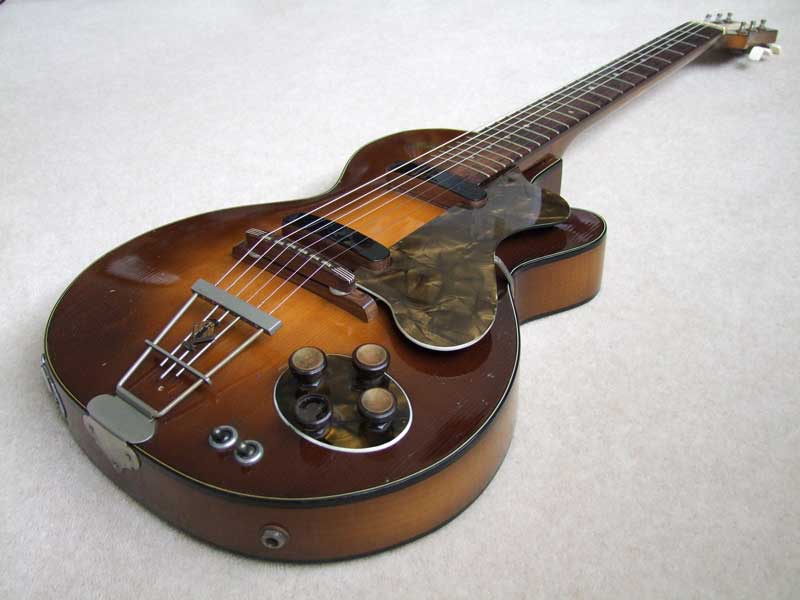
In 1955, Walter Hӧfner
introduced a small bodied (13” lower bout width) electric guitar to the main
Hӧfner range. This had a fully hollow body with an arched solid spruce top, a
flat flame-maple back, and no sound holes! At first glance it could have been
mistaken for a certain solid guitar model that the Gibson Company had brought
out a couple of years previously in 1952. Walter’s guitar however was of totally
different construction and definitely sounded much differently. The only finish
offered on the first guitars was varnished brown sunburst, and that together
with the simple black binding and modest strip purfling offered made the guitar
appear a little drab. Very soon after though, a blonde finish option was offered.
Either one or two pickup versions were offered,
and this was therefore Hӧfner’s first attempt at a fully dedicated electric
guitar rather than an acoustic model which had been fitted with pickups almost
as an afterthought. These two models were a significant leap forward for Hӧfner.
The single pickup guitar was designated as the Hӧfner 125 model and the twin
pickup as the 126.
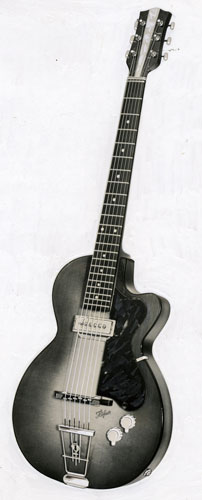 1954/55 Hӧfner Model 125 |
As introduced in 1955, the main details of the
Club-Style 125 and 126 models were:
|
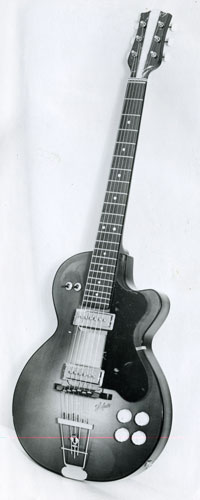 1954/55 Hӧfner Model 126 |
The
dimensions of the 125 and 162 were so similar to the Gibson Les Paul that the
question must be asked “did Walter make a conscious decision to emulate that
famous guitar”? Well, no one knows of course, but it would have been logical for
Walter to closely observe the trends in the US guitar market, possibly by means
of catalogues supplied by his associate Ben Davies of the Selmer Company in
London. Having spent his life building guitars on the same basis as for
hollow-bodied orchestral stringed instruments, Walter would have been much more
comfortable making a small body electric guitar using that same technique rather
than using what he would have considered to be extravagant quantities of solid
tone-wood as in the case of the Gibson and that new company in California called
Fender. The German luthiers in the mid-1950’s were prepared to be innovative,
but solid bodies for stringed instruments was just a step too far for them at that time.
By September 1955, these two little guitars were also
appearing in
the Selmer London advertising. However, as with the other models sold by Selmer,
Ben Davies did not consider model numbers to be appropriate for the British
market, and so they were called the Club 40 and the Club 50. It took Hӧfner
themselves a couple of years to latch onto the “Club” name and it was only in
their 1958 standard European (non-UK) catalogue that such models appeared under
the heading of “Club-Style”.
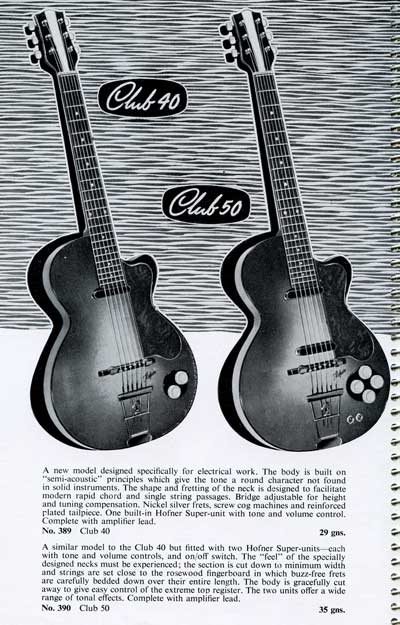 Club 40 & 50 as advertised in the 1958 Selmer London Catalogue |
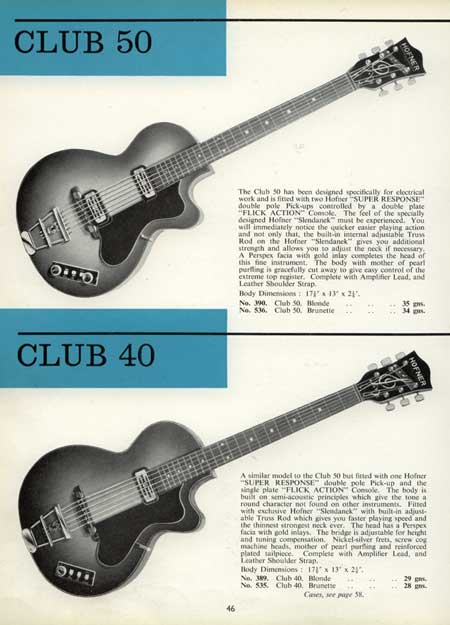 Club 40 & 50 in the 1961 Selmer London Catalogue |
The two Hӧfner Club-Style guitars sold quite well in the mid to late 1950’s, possibly because players found them much easier to handle rather than the large-bodied archtops which were in the majority at that time. It would seem that the vast majority of the Club 40 & 50 guitars imported by Selmer were blondes. Selmer were very discerning with regard to the appearance and therefore the saleability of their products with Ben and Lew only wanted the best for their customers. It is rather strange therefore that Selmer's catalogues generally only displayed brunette-finished examples of the two models. Blonde though does appears to have been the UK's favourite.
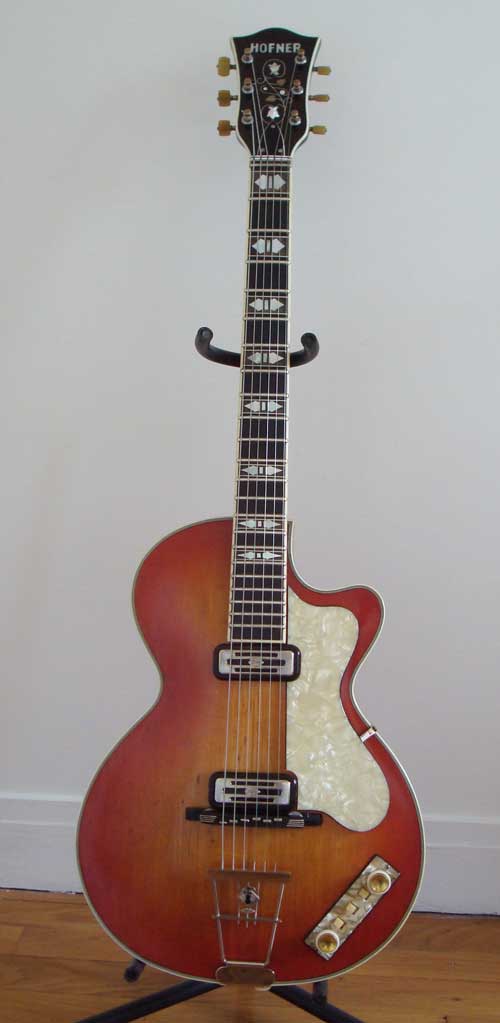 1960 Hofner Club 60 (AKA Hӧfner 128 model) |
By early 1958, the Club 40 and 50 had been joined in the
Selmer catalogue by a
deluxe version called of course the Club 60. This model was almost certainly
introduced at Ben Davies’ instigation, following his usual wish to raise the
standard of the Hӧfner models sold by Selmer. Fitted with two pickups and
Hӧfner’s latest rectangular control console, this guitar was later introduced
into the Hӧfner main range in 1960 as the Hӧfner 128 model. A single pickup
version called the 127 was also offered at the same time to the rest of the
world, but for some unknown reason Selmer decided not to adopt that version. The new
Club 60, 127, and 128 models had received the full cosmetic job of
mother-of-pearl inlays and multilayer purfling around the body edges, together
with a bound 5-piece neck and individual “hydrant” tuners. The blonde finish was
of course a top favourite but another option of a lovely red/yellow
sunburst was provided from 1960, usually mated with black rims and neck; perhaps
once again influenced by the cherry red sunburst used on the famous Gibson
Les Paul Standard. Details of the first Hӧfner Club 60 (AKA Hӧfner 127/128)
were in addition to the Club 40 and 50:
|
 Left-handed Hӧfner 127 Model |
The Club-Style guitars were very popular with European
and UK musicians involved in certain styles of music, particularly rock n’ roll
and that very British late-1950’s phenomenon called “skiffle”. However, the
Clubs are most closely associated with the many Dutch “Indorock” Bands in the
late 1950’s and early 60’s. Imported in large numbers by Hӧfner’s Amsterdam
distributor Van Wouw, these little guitars were snatched up by the Dutch
Indonesian immigrants who, after finding a home in The Netherlands, had formed
bands in order to use the Indonesian cultural love of the guitar to play their
style of music in their new country.

It is also interesting to see old photos of some of the
British guitar gods playing Club guitars. As well as the obvious examples of
John, Paul and George during the Beatles’ formative days, Dave Gilmour, Richie
Blackmore, Justin Haywood, Joe Brown, and John McNally of The Searchers are
amongst many others who cut their guitar-playing teeth with Hӧfner Clubs.
As time went on, the “Club-Style” models were modified in line with Hӧfner practice of the time. A succession of different pickups were provided, together with headstock designs. The first of the more fundamental changes occurred in 1957 when the solid carved body top was replaced by a pressed spruce laminate. In 1958, the original circular/oval control console was replaced by the now familiar Hӧfner rectangular console, and at the beginning of 1960 the previously flat back changed to domed.
Unfortunately, the “Club” concept ran out of steam
fairly quickly in Britain, which was a shame as they are very playable little
guitars. Their sound is rather an acquired taste but there is nothing else
out there quite like it. In 1962, sales were so low that Selmer finally dropped
the three models (Club 40, 50 & 60) from their Autumn 1963 catalogue. It would
appear from the illustration in the Spring 63 catalogue that a change from the
rectangular console to four rotary controls was planned, presumably in an
attempt to provide a more “Les Paul” appearance, but it was all to no avail.
Selmer effectively stopped selling Club guitars in 1962.
Matters were not much better in Hӧfner’s other markets.
Very few 125/126/127/128 guitars can be found these days that were made after
1962. They were still featured in Hӧfner’s major catalogue revamp of 1963/64 but
after that they just did not feature in Hӧfner advertising. They did however all
stay in Hӧfner’s large rambling price list until 1970, but this
was probably only to provide an indication that they were still available for
purchase to order, maybe bearing in mind that a stock of Club bodies and necks were still
stored away at the back of the workshop.
1967 Hӧfner Model 126 Club-Style
Perhaps to help use up such obsolete items, a new Club
model appeared out of the blue on the Selmer stand of the UK Music Trade fair in
Autumn 1967. This was called the Club 70, which despite its title was not a
higher-quality guitar than the old Club 60 had been. It did however have two of
the latest Hӧfner pickups, the Type 512 “Blade” units, mated to a similar
control system to that of the Gibson Les Paul itself, i.e. two rotary volume
controls, two rotary tone controls, and a three-way pickup selector switch which
was located on the top bout, just as on an LP. (However, at least one Club 70
exists fitted with just one rotary volume control and two rotary tone controls,
plus a three-way selector.)
Supplied only in tobacco brown
sunburst, the Club 70 was in fact a rather austere looking little guitar,
perhaps in the tradition of the Club 40/50, with simple single dot fret markers,
a plastic “Treble Clef” headstock fascia, and no binding to the neck. It was also
a poor seller, with only about 60 guitars being sold before being dropped by
Selmer in 1969.
Whilst talking about commercial
failures, perhaps we should finish this section by referring to one final
Club-Style version that was born and died in 1960. This was the Hӧfner 1260
Model, the first of only three models with built-in amplification to be produced
by the company. As we have seen earlier in this book, Walter appears to have
been fascinated by electronics, also introducing active circuits into the
options available throughout his archtop range in Spring 1960. The 1260 was
fitted with a small loudspeaker mounted under the body top of a normal 126 model
and provided with a lovely sculptured art-nouveau speaker grill on the body top
itself. This was powered by means of a germanium transistor amplifier with a 3
watts output, also mounted inside the body of the guitar.
Unfortunately, only
heavy transformers and 9 volt batteries were available for use in the amplifier
and this made the guitar un-bearably heavy. In addition, feedback through the
loudspeaker was horrendous, so this model did not really get past the stage of
being a prototype, although it was referred to in Hӧfner’s New Models Spring
Price List for 1960. Also included in that price list was an un-named but now
better known guitar, with built in amplification, which these days is referred
to as the Hӧfner Fledermausguitarre. This crazy looking guitar was
slightly more successful prototype than the 1260, with an estimated eleven “Bat Guitars”
made. Needless to say, neither model made it into the main Hӧfner catalogue!
__________________________________________________
All Text is Copyright
© 2022 Steve Russell. All Rights Reserved